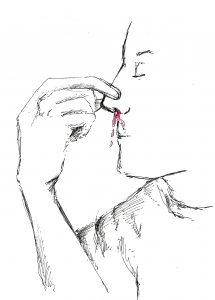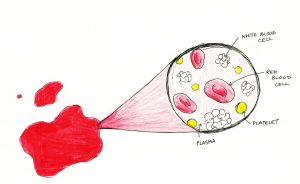
Author: Layal Bou Abdo MNS
Illustration: Angeline Boswell
Were you playing outside yesterday and got a nosebleed? Did you get worried? It might seem scary to see blood coming out of your nose, but this is something that happens often to some kids. … and true, it doesn’t hurt!
Your body is brilliant, and it can repair itself if you get injured! We will show you how!
Before we start talking about why do we get them and how to take care of them try to answer those questions first.
- How was yesterday’s weather? Was it dry, cold or windy?
- Did you put anything inside your nose?
- Have you picked your nose?
- Did you hit your nose?
- Did you blow your nose very strongly?

Pressure and Patience to stop the bleed
How does it happen?
Your face has blood vessels more than anywhere else in your body. Up in your nose, there are tiny blood vessels endings very close to the surface. Those blood vessels are delicate and fragile. When something causes a crack or scratch in our nostrils – the two small holes in your nose- it can open up those blood vessels. It’s like getting a cut but this time, inside your nose.
What can cause the crack or scratch inside our nostrils?
- Normally, the air has a bit of water vapour in it that will keep your nose a bit wet from the inside. When the air around us is very dry, it can dry out our noses a little bit as we breathe. This happens more when the climate is dry, cold or windy or even heated indoor air that can cause the nasal membranes to dry out. For some people, when they breathe in dry air, it can cause the inside of their nose to dry out making the blood vessels easy to crack causing a nosebleed.
- Scratching inside the nose, or … yes NOSE PICKING that can scratch and open a blood vessel too. Nothing should go inside your nostrils, not even your fingers.
- Colds or infections in the nasal cavities might irritate the inside of the nose cause more dryness. Bleeding may happen after repeated nose-blowing. When you combine a cold with dry winter air, you have the perfect formula for nosebleeds.
- Allergies causing itchy, runny, or stuffy nose. Also, some allergy medications prescribed by your doctor can dry out our nostrils and contribute to nosebleeds.
- An injury or trauma to the nose
- Other causes not common for kids: Certain medications or substances, bleeding disorders, pregnancy.
Types of nosebleed
There are two different kinds of nosebleeds?
- Anterior nosebleeds, that are the most common. When the blood comes out from your nostrils.
- Posterior nosebleeds, coming from the deepest parts of the nose. When the blood flows down the back of the throat. These usually happen when you have a trauma or injury to the face or nose or also which older people who have high blood pressure.
How does the body repair itself?
Imagine you have a hole in your backyard lawn that you want to repair.
Step1, you need to fill the gap by adding some soil. Identically, your body will plug this gap using his platelets (a kind of blood cells that help to stop the bleeding and sticking together like glue)
Step 2, you spread the seeds and water them. Similarly, your body brings into the wound a bleeding protein called fibrin to create a big structure called a scab to seal the wound.
Step 3, your grass starts to grow. Likewise, new skin cells will form on the top.
Step 4, you continue to water the seed so everything can look new again. Equally, in your body, everything is cleaned by plasmin that dissolves the scab once the skin regenerates as new.
We found this cool video that teaches you all about the blood and coagulation process from Operations Ouch, don’t do any of these experiments at home!

Composition of the blood
How can I stop Nosebleed?
To stop the nosebleed, you need Pressure and Patience:
- Stay calm and remind yourself that you just need to help your body to heal up
- Grab a box of tissues or a damp cloth to catch the blood and soak up any blood that might come out. DO NOT blow your nose into the tissues even if you felt that you need to do so. That could make the blood vessels start bleeding again; let the blood find its way out of the nose.
- Sit up or stand
- DO NOT pack your nose with a tissue
- DO NOT tilt your head backward, this will cause the blood to run into your throat. This can make you cough or even choke, and if you swallowed the blood, you might vomit. Instead, tilt your head forward so the blood can run out easily from your nose.
- Pinch your nostrils together just below the bony part of your nose. As you pinch your nose, your blood vessels are working hard to cover themselves back up to stop the bleeding. Applying pressure helps stop the blood flow and the nosebleed will usually stop with 10 – 15 minutes of pressure.
- After 10 – 15 min, check if the bleeding has stopped and resume pinching for another 10 – 15 min if your nose is still bleeding.
- Breathe from your mouth and relax while waiting.
- Don’t forget to wash your hands and face after the nosebleed stops.
- It is always wise to call an adult to help you and to see a doctor if the nosebleed did not stop after the second attempt. The doctor will check the nose to find out where the bleeding is coming from the inside of the nose. The doctor may treat the bleeding with a medical procedure called nasal cautery. During cautery, the doctor uses a tool to chemically burn the area of the bleeding. This prevents further bleeding episodes.
- After you’ve stopped the nosebleed, try not to lift heavy objects or do intense activities, and try not to blow your nose for 24 hours.
Healthy habits to prevent nosebleeds
- Blow your nose gently especially when you have a cold.
- Avoid picking your nose or putting anything inside.
- Use a humidifier when the outside climate is dry.
- Stay away from allergens or from what can trigger your allergies.
- Your mom might want to spray the inside of your nose with saline (saltwater) to keep your nose moist.
- Wear protective equipment when you are playing sports that could cause injuries.
Are you still worried about your nosebleeds? We bet you are not! – now you know what to do!
Fun Facts about your nose:
- Your nose has an internal humidifier called Turbinates, that prevent the dry air to pass through your throat and lungs. Do you know now why your throat feels dry when you’ve been breathing a long time through the mouth: The inhaled air didn’t get humidified in the nose.
- The air we breathe has all kinds of stuff in it – from oxygen and nitrogen to dust, pollution, allergens, smoke, bacteria, viruses, small bugs and countless other things. The nose helps clean that air. Inside your nose, particularly the turbinates, are small hair-like called cilia that trap much of the bad stuff. The bad stuff sits in the mucous and gradually is pushed into the throat, where it’s swallowed. Our stomachs tolerate bad stuff much better than our lungs.
- Cilia sweep mucus to the back of the nose every five to eight minutes.
- Nasal membrane colour is an indicator of health. Pink indicates a healthy nasal membrane, red signifies infection and muted pink and gray appear during nasal allergy season.
- Your nose and sinuses produce almost one litre of mucus a day (which you swallow) – That’s Gross!
- A single sneeze makes 40,000 droplets, travels up to 20 miles per hour, and creates a 5’ spray radius.
- You don’t sneeze in your sleep because the nerves that trigger sneezing are also sleeping.
- Hungry? 80% of what you’re tasting is determined by what you’re smelling.
- Mucus contains chemicals that keep you healthy. That’s why when you’re sick, mucus production nearly doubles.
- Humans have 12 million olfactory receptor cells (smell receptors), while rabbits have 100 million and dogs have four billion.
- ‘Anosmia’ is the inability to smell. ‘Dysosmia’ is when things don’t smell as they should (like when you have a cold). ‘Hyperosmia’ is having a very strong sense of smell.
- Your Sneeze style may be genetic. Some honk, some shout, some just can’t seem to stop — your style of sneezing is one of the many things that makes you who you are. The process of sneezing is called sternutation.
- The nose grows downward. Your nasal shape is formed by age 10, and your nose continues to grow slowly until about age 15 to 17 in women and about age 17 to 19 in men. But over time, the nose lengthens and droops due to the gravity and the decrease in the collagen and elastin in your skin.
We are certain your kid asks you health (human & animal) questions that genuinely leave you stumped! Leave a comment below and we are happy to answer “why” in future blogs.
Copyright © 2020 Little Medical School Ottawa

[…] of the jaw increases blood flow in the neck, face, and skull. Each yawn pumps air into the upper respiratory system in the upper and lower nasal cavities and the sinuses which have mucus membranes covered with many […]
[…] much harder on the heart and its vessels to pump blood to the entire body organs. That’s one reason why some people get varicose veins*. The veins […]
Nice article
Thank you 🙂
Great information about Nosebleeds . it’s really helpful for the reader.